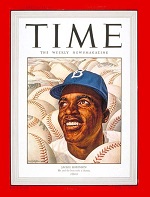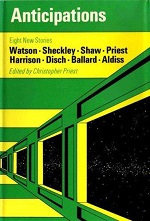|  
 
 
 
 
 
 
 | | | | 

| | The Hitchhiker’s Guide
to the Galaxy
by Douglas Adams
First time travel: BBC Radio, 29 Mar 1978

 Apart from the original radio programs that I listened to in Stirling on my study abroad, the travails of Arthur Dent dodging Vogons never inflamed my passion—and I’m not quite sure where time travel slipped into the further radio shows, books, tv shows, movies and video games (which I won’t list here, apart from noting Tim’s favorite quote from The Restaurant at the End of the Universe: “There was an accident with a contraceptive and a time machine. Now concentrate!” Still, those original radio shows got me laughing, including the first moment of time travel in the 4th episode. Apart from the original radio programs that I listened to in Stirling on my study abroad, the travails of Arthur Dent dodging Vogons never inflamed my passion—and I’m not quite sure where time travel slipped into the further radio shows, books, tv shows, movies and video games (which I won’t list here, apart from noting Tim’s favorite quote from The Restaurant at the End of the Universe: “There was an accident with a contraceptive and a time machine. Now concentrate!” Still, those original radio shows got me laughing, including the first moment of time travel in the 4th episode.

The radio series spawned six books and at least one time-travel infused short story.- The Hitchhiker’s Guide to the Galaxy (1979)
- The Restaurant at the End of the Universe (1980)
- Life, the Universe and Everything (1982)
- So Long, and Thanks for All the Fish (1984)
- “Young Zaphod Plays It Safe” (1986) in The Hitchhiker’s Quartet
- Mostly Harmless (1992)
- And Another Thing . . . (2009) by Eoin Colfer
 For instance, at the very moment that Arthur Dent said, “I seem to be having this tremendous difficulty with my lifestyle,” a freak wormhole opened up in the fabric of the space-time continuum and carried his words far, far back in time across almost infinite reaches of space, to a distance galaxy where strange and war-like beings were poised on the brink of frightful interstellar battle. For instance, at the very moment that Arthur Dent said, “I seem to be having this tremendous difficulty with my lifestyle,” a freak wormhole opened up in the fabric of the space-time continuum and carried his words far, far back in time across almost infinite reaches of space, to a distance galaxy where strange and war-like beings were poised on the brink of frightful interstellar battle. 

—from the 4th radio episode
| |
| | | | |

 
 
 
 
 
 
 
 | | | |  | | “The Very Slow Time Machine”
by Ian Watson
First publication: Anticipations, Sep 1978

 In 1985, a small inpenetrable living pod appears out of nothing at the National Physics Laboratory. A window on one side shows the pod’s occupant: a delirious man who grows younger and saner through the years, although generally doing little other than sitting and reading, leading the observers to conclude that his quarters are in fact a VSTM taking him back through time at the rate of one year for each year of his life. In 1985, a small inpenetrable living pod appears out of nothing at the National Physics Laboratory. A window on one side shows the pod’s occupant: a delirious man who grows younger and saner through the years, although generally doing little other than sitting and reading, leading the observers to conclude that his quarters are in fact a VSTM taking him back through time at the rate of one year for each year of his life.

As of writing this, I am only partway through my reading and wondering so many things: When the man in the world at large who will eventually enter the machine realize that he is the traveler? From his perspective, what happened to the machine (and him!) when it materialized in 1985? (Ah! That question is answered shortly after it occurs to me.) For that matter, why doesn’t he himself, while in the pod, already know that he will reach 1985? To what extent does his very appearance cause the technology that permits his trip to occur? VCIS! (Very Cool Idea-Story!), although it offers little in plot or character. Our passenger is the object of popular cults by now—a focus for finer feelings. In this way his mere presence has drawn the world’s peoples closer together, cultivating respect and dignity, pulling us back from the brink of war, liberating tens of thousands from their concentration camps. These cults extend from purely fashionable manifestations—shirts printed with his face, now neatly shaven in a Vandyke style; rings and worry-beads made from galena crystals—through the architectural (octahedron and cube meditation modules) to life-styles themselves: a Zen-like “sitting quietly, doing nothing”. Our passenger is the object of popular cults by now—a focus for finer feelings. In this way his mere presence has drawn the world’s peoples closer together, cultivating respect and dignity, pulling us back from the brink of war, liberating tens of thousands from their concentration camps. These cults extend from purely fashionable manifestations—shirts printed with his face, now neatly shaven in a Vandyke style; rings and worry-beads made from galena crystals—through the architectural (octahedron and cube meditation modules) to life-styles themselves: a Zen-like “sitting quietly, doing nothing”. 
| |
| | | | |

 
 
 
 
 
 
 
 | | | | 

| | Superman: The Movie
by Jerry Siegel, Joe Shuster, Mario Puzo, et. al. (Richard Donner, director)
First release: 15 Dec 1978

The humor didn’t quite click for me, but I did enjoy other parts including Christopher Reeve, Gene Hackman, the John Williams score, and a well-presented Superman mythos including his first time-travel rebellion against the don’t-mess-with-history edict of Jor-El. In times of fear and confusion, the job of informing the public was the responsibility of the Daily Planet, a great metropolitan newspaper whose reputation for clarity and truth had become the symbol for hope in the city of Metropolis. In times of fear and confusion, the job of informing the public was the responsibility of the Daily Planet, a great metropolitan newspaper whose reputation for clarity and truth had become the symbol for hope in the city of Metropolis. 
| |
| | | | |

No Time Travel. Move along. |
“A Time-Span to Conjure With” by Ian Watson, Andromeda 3, 1978 [despite title, no time travel ]

“Thirty Love” by Jack C. Haldeman II, Asimov’s Science Fiction, Sep 1979 [precognition ]

| |     |